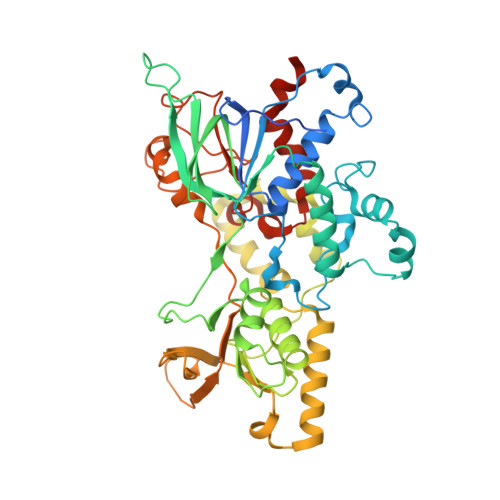Structural Determinants of Flavin Dynamics in a Class B Monooxygenase.
Campbell, A.C., Robinson, R., Mena-Aguilar, D., Sobrado, P., Tanner, J.J.(2020) Biochemistry 59: 4609-4616
- PubMed: 33226785
- DOI: https://doi.org/10.1021/acs.biochem.0c00783
- Primary Citation of Related Structures:
7JVK, 7JVL - PubMed Abstract:
The ornithine hydroxylase known as SidA is a class B flavin monooxygenase that catalyzes the first step in the biosynthesis of hydroxamate-containing siderophores in Aspergillus fumigatus . Crystallographic studies of SidA revealed that the FAD undergoes dramatic conformational changes between out and in states during the catalytic cycle. We sought insight into the origins and purpose of flavin motion in class B monooxygenases by probing the function of Met101, a residue that contacts the pyrimidine ring of the in FAD. Steady-state kinetic measurements showed that the mutant variant M101A has a 25-fold lower turnover number. Pre-steady-state kinetic measurements, pH profiles, and solvent kinetic isotope effect measurements were used to isolate the microscopic step that is responsible for the reduced steady-state activity. The data are consistent with a bottleneck in the final step of the mechanism, which involves flavin dehydration and the release of hydroxy-l-ornithine and NADP + . Crystal structures were determined for M101A in the resting state and complexed with NADP + . The resting enzyme structure is similar to that of wild-type SidA, consistent with M101A exhibiting normal kinetics for flavin reduction by NADPH and wild-type affinity for NADPH. In contrast, the structure of the M101A-NADP + complex unexpectedly shows the FAD adopting the out conformation and may represent a stalled conformation that is responsible for the slow kinetics. Altogether, our data support a previous proposal that one purpose of the FAD conformational change from in to out in class B flavin monooxygenases is to eject spent NADP + in preparation for a new catalytic cycle.
Organizational Affiliation:
Department of Biochemistry, University of Missouri, Columbia, Missouri 65211, United States.


















